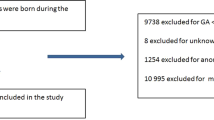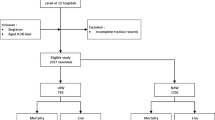Abstract
OBJECTIVE: To determine patterns of survival for very low birth weight (VLBW, birth weight 501 to 1500 g) neonates over 23 years.
STUDY DESIGN: Data for 4873 VLBW neonates born from 1977 to 2000 were divided into five epochs. The primary outcome was survival to hospital discharge. Birth weight-specific survival rates were estimated by race and gender for each epoch. Presence of comorbidities and congenital anomalies, delivery mode, and provision of artificial ventilation were investigated to determine whether they could explain observed survival patterns.
RESULTS: From 1977 to 1995, survival increased from 50.2% to 81.0% as the proportion of VLBW neonates receiving artificial ventilation rose from 59.0% to 80.9%. Survival was unchanged between 1990 to 1995 and 1996 to 2000. Black females maintained a survival advantage over the entire study period. Survival improved for neonates with congenital anomalies over time, but had little impact on race/gender survival patterns. Survival patterns also could not be explained by comorbidity status, delivery mode, or access to artificial ventilation.
CONCLUSION: The survival advantage of VLBW black females persists and remains unexplained.
This is a preview of subscription content, access via your institution
Access options
Subscribe to this journal
Receive 12 print issues and online access
$259.00 per year
only $21.58 per issue
Buy this article
- Purchase on SpringerLink
- Instant access to full article PDF
Prices may be subject to local taxes which are calculated during checkout

Similar content being viewed by others
References
Stahlman M . Newborn intensive care: success or failure? J Pediatr 1984;105:162–167.
Kilbride H, Daily D, Claflin K, Hall R, Maulik D, Grundy H . Improved survival and neurodevelopment outcome for infants less than 801 grams birthweight. Am J Perinatol 1990;7:160–165.
Buehler J, Kleinman J, Hogue C, Strauss L, Smith J . Birth weight-specific infant mortality, United States, 1960 and 1980. Public Health Rep 1987;102:151–161.
Roth J, Resnick M, Ariet M . et al. Changes in survival patterns of very low-birth-weight infants from 1980 to 1993. Arch Pediatr Adolesc Med 1995;149:1311–1317.
Iyashu S, Becerra J, Rowley D, Hogue C . Impact of very low birthweight on the black–white infant mortality gap. Am J Prev Med 1992;8:271–277.
Carmichael S, Iyasu S . Changes in the black–white infant mortality gap from 1983 to 1991 in the United States. Am J Prev Med 1998;15:220–227.
Binkin N, Rust K, Williams R . Racial differences in neonatal mortality: what causes of death explain the gap? AJDC 1988;142:434–440.
Brothwood M, Wolke D, Gamsu H, Benson J, Cooper D . Prognosis of the very low birthweight baby in relation to gender. Arch Dis Child 1986;61:559–564.
Resnick M, Carter R, Ariet M . et al. Effect of birth weight, race, and sex on survival of low-birth-weight infants in neonatal intensive care. Am J Obstet Gynecol 1989;161:184–187.
Hoffman E, Bennett F . Birth weight less than 800 grams: changing outcomes and influences of gender and gestation number. Pediatrics 1990;86:27–34.
Stevenson D, Wright L, Lemons J . et al. Very low birth weight outcomes of the National Institute of Child Health and Human Development Neonatal Research Network, January 1993 through December 1994. Am J Obstet Gynecol 1998;179:1632–1639.
O'Shea T, Klinepeter K, Goldstein D, Jackson B, Dillard R . Survival and developmental disability in infants with birth weights of 501 to 800 grams, born between 1979 and 1994. Pediatrics 1997;100:982–986.
Sanchez A, Mize S, Jimenez J, Manroe B, Rosenfeld C, Tyson J . Systems approach to the evaluation of maternal and neonatal care, selected papers in medical information processing. In: Twelfth Hawaii International Conference on Systems Sciences 1979 p. 140–151.
Bell M, Ternberg J, Feigin R . et al. Neonatal necrotizing enterocolitis: therapeutic decisions based upon clinical staging. Ann Surg 1978;187:1–7.
Cuzick J . A Wilcoxon-type test for trend. Stat Med 1985;4:87–90.
Iezzoni L . Risk Adjustment for Measuring Healthcare Outcomes. 2nd ed. Chicago: Health Administration Press; 1997.
Sasani P . sg29.1: tabulation of observed/expected ratios and confidence intervals: Update. In: Becketti S, editor. Stata Technical Bulletin Reprints. College Station, TX: Stata Corporation; 1996 p. 87–90.
Fujikura T, Froehlich L . The influence of race and other factors on pulmonary hyaline membranes. Am J Obstet Gynecol 1966;95:572–578.
Robillard P, Hulsey T, Alexander G, Sergent M, de Caunes F, Papiernik E . Hyaline membrane disease in black newborns: does fetal lung maturation occur earlier? Eur J Obstet Gynecol Reprod Biol 1994;55:157–161.
Perelman R, Palta M, Kirby R, Farrell P . Discordance between male and female deaths due to the respiratory distress syndrome. Pediatrics 1986;78:238–244.
Teberg A, Hodgman J, Barton L, Chan L . Nursery survival for infants of birth weight 500–1500 grams during 1982–1995. J Perinatol 2001;21:97–106.
Markides K, Coreil J . The health of Hispanics in the Southwestern United States: an epidemiologic paradox. Public Health Rep 1986;101:253–265.
Fuentes-Afflick E, Lurie P . Low birth weight and Latino ethnicity: examining the epidemiologic paradox. Arch Pediatr Adolesc Med 1997;151:665–674.
Zuvekas A, Wells B, Lefkowitz B . Mexican American infant mortality rate: implications for public policy. J Health Care Poor Underserved 2000;11:231–257.
La Pine T, Jackson J, Bennett F . Outcome of infants weighing less than 800 grams at birth: 15 years' experience. Pediatrics 1995;96:479–483.
Piecuch R, Leonard C, Cooper B, Sehring S . Outcome of extremely low birth weight infants (500 to 999 grams) over a 12-year period. Pediatrics 1997;100:633–639.
Blaymore-Bier J, Pezzullo J, Kim E, Oh W, Garcia-Coll C, Vohr B . Outcome of extremely low-birth-weight infants: 1980–1990. Acta Paediatr 1994;83:1244–1248.
Harper R, Rehman K, Sia C . et al. Neonatal outcome of infants born at 500 to 800 grams from 1990 through 1998 in a tertiary care center. J Perinatol 2002;22:555–562.
Hack M, Horbar J, Malloy M, Tyson J, Wright E, Wright L . Very low birth weight outcomes of the National Institute of Child Health and Human Development Neonatal Network. Pediatrics 1991;87:587–597.
Hack M, Wright L, Shankaran S . et al. Very-low-birth-weight outcomes of the National Institute of Child Health and Human Development Neonatal Network, November 1989 to October 1990. Am J Obstet Gynecol 1995;172:457–464.
Fanaroff A, Wright L, Stevenson D . et al. Very-low-birth-weight outcomes of the National Institute of Child Health and Human Development Neonatal Research Network, May 1991 through December 1992. Am J Obstet Gynecol 1995;173:1423–1431.
Lemons J, Bauer C, Oh W . et al. Very low birth weight outcomes of the National Institute of Child Health and Human Development Neonatal Research Network, January 1995 through December 1996. Pediatrics 2001;107:e1.
Horbar J, Badger G, Carpenter J . et al. Trends in mortality and morbidity for very low birth weight infants, 1991–1999. Pediatrics 2002;110:143–151.
Philip A . Neonatal mortality rate: Is further improvement possible? J Pediatr 1995;126:427–433.
Kramer M, McLean F, Boyd M, Usher R . The validity of gestational age estimation by menstrual dating in term, preterm, and postterm gestations. JAMA 1988;260:3306–3308.
Acknowledgements
We are indebted to Kathleen A. Kennedy, MD for her support of this project.
Author information
Authors and Affiliations
Rights and permissions
About this article
Cite this article
Kaiser, J., Tilford, J., Simpson, P. et al. Hospital Survival of Very-Low-Birth-Weight Neonates from 1977 to 2000. J Perinatol 24, 343–350 (2004). https://doi.org/10.1038/sj.jp.7211113
Published:
Issue date:
DOI: https://doi.org/10.1038/sj.jp.7211113
This article is cited by
-
Growth after implementing a donor breast milk program in neonates <33 weeks gestational age or birthweight <1500 grams: Retrospective cohort study
Journal of Perinatology (2023)
-
Craniofacial growth in infants with deformational plagiocephaly: does prematurity affect the duration of head orthosis therapy and the extent of the reduction in asymmetry during treatment?
Clinical Oral Investigations (2020)
-
Renal function and blood pressure are altered in adolescents born preterm
Pediatric Nephrology (2019)
-
Prospective study of early and late outcomes of extremely low birthweight in Central Saudi Arabia
BMC Pediatrics (2018)
-
Impact of child health and disability on subsequent maternal fertility
Review of Economics of the Household (2017)



